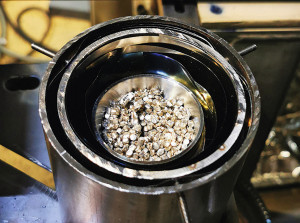The joint project "nextBatt", funded by the German Federal Ministry of Education and Research (BMBF), aims to develop resource-efficient production processes for next-generation battery anodes. The Fraunhofer Institute for Organic Electronics, Electron Beam and Plasma Technology FEP in Dresden has developed new material combinations and an efficient new coating technology for this purpose, which has now been presented in the USA.
The demand for lithium-ion batteries (LIB) is increasing rapidly. In 2020, the Fraunhofer Institute for Systems and Innovation Research ISI expected the demand for lithium-ion cells for electromobility alone to increase by a factor of 20 to 40 by 2030.
To ensure that the use of resources does not also increase immeasurably with the increased demand for batteries, scientists around the world are working feverishly on improvements. The partners of the 2021 "nextBatt" project - in addition to the Fraunhofer FEP, the Fraunhofer Institutes for Material and Beam Technology IWS, for Solar Energy Systems ISE and for Surface Engineering and Thin Films IST - are making a significant contribution to this.
"Increases in energy density of up to 65% are possible for lithium-ion batteries," predicts Dr. Stefan Saager, project manager at Fraunhofer FEP. "This can be achieved by replacing conventional graphite anodes with anodes based on silicon and, in future, metallic lithium. With the resource-efficient process technologies at Fraunhofer FEP, we have already succeeded in producing pure metallic lithium layers and also lithium-silicon compound layers on a production-relevant scale."
Lithium in its original form as granules (left) and deposited as a thin layer (right) as the basis for the production of innovative and efficient next-generation batteries
Lithium layers are usually produced in the form of thin films using rolling processes, which also require the use of lubricants. At the Fraunhofer FEP, however, the lithium layers are produced in a thickness of 1-20 µm by thermal vapor deposition in a vacuum without any contaminating additives.
This allows very pure and, above all, thin metallic lithium layers to be produced in a reproducible manner. In this process, lithium granulate is transferred into a vacuum, filled into a crucible and then heated to temperatures of 500-700 °C. The lithium is melted and then deposited in a crucible. The lithium is melted and finally vaporized. Similar to how water collects on the lids of cooking pots, the spreading lithium vapor is deposited on a substrate. This substrate is moved over the lithium vapor source in a controlled manner so that a lithium layer of a predetermined thickness condenses on it.
A major challenge in the development of the technology was not only setting up the processes, but also the working environments, as lithium is extremely reactive. Lithium reacts not only with oxygen in the air, but also with nitrogen. Lithium also combines with water to form strongly basic lithium hydroxide, releasing hydrogen. These reactions are known to be highly exothermic, which makes them difficult to handle and places increased demands on occupational safety. Lithium can therefore only be handled in an inert argon atmosphere. In addition, high-purity lithium layers are essential for achieving good battery performance. The Fraunhofer FEP facilities have been prepared accordingly for experiments with air-sensitive materials such as lithium.
A major advantage of the technology is that the vapor deposition process can also be used to produce compound layers in combination with other materials, such as silicon. To do this, another vapor source with a different starting material is "simply" installed next to it. The different materials mix in the two superimposed vapor streams and produce a compound layer with the desired composition on the substrate. In this way, very promising material combinations can be realized that could not be produced in any other way. In addition, very high coating rates can be achieved with this process - an important criterion for transferring the technology to mass production.
The pure lithium coatings produced at the Fraunhofer FEP to date were examined at the Fraunhofer IWS with regard to their electrochemical properties. This showed that approx. 80 % of the deposited lithium was electrochemically active - i.e. it can be used in a battery for chemical reactions to store energy. A further increase of over 90 % is in prospect through the optimization of process steps. This improvement includes various processes for substrate cleaning and pre-treatment, the coating technology itself and finishing processes through post-treatment. The reduction of so-called "dead lithium" is an essential key to increasing efficiency in batteries and is the subject of extensive international research.
The Fraunhofer FEP has test and pilot plants available for this purpose, with which, for example, metallic plates and strips or plastic films can be processed in an efficient roll-to-roll process. The project consortium is developing other promising technologies for increasing battery performance, such as processes for surface coating and processing powders, metallization of plastic films for lightweight current collectors or plasma processes for producing alternative electrode materials. Due to the proximity to the partners, comprehensive characterization options are available at the Fraunhofer IWS without having to consider long storage and transport times for the sensitive materials.
The Fraunhofer Institutes are already in contact with various partners from research and industry. The scientists estimate that if research activities are intensified, the coating technology could find its way into the production of next-generation batteries within the next five years. The "nextBatt" project represents a decisive step in paving the way for this.
The Fraunhofer Institute for Organic Electronics, Electron Beam and Plasma Technology FEP presented the latest research results at the Society of Vacuum Coaters conference in Long Beach/USA from May 3 to 5, 2022.




